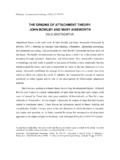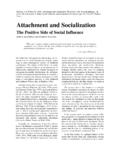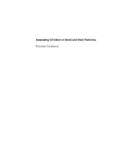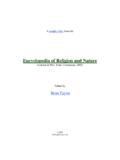Transcription of Modern Attachment Theory: The Central Role of …
1 ORIGINAL PAPERM odern Attachment theory : The Central Role of AffectRegulation in Development and TreatmentJudith R. Schore Allan N. SchorePublished online: 8 September 2007 Springer Science+Business Media, LLC 2007 AbstractOver the past decade Attachment theory hasundergone an intense expansion of both its original scien-tific foundations as well as its applications to clinical s original description occurred during a period ofbehaviorism and an emphasis on the strange situation andsecure base behaviors, which then gave way to a domi-nance of cognition and an emphasis on attachmentnarratives and reflective capacities. We will argue that inline with Bowlby s fundamental goal of the integration ofpsychological and biological models of human develop-ment, the current interest in affective bodily-basedprocesses, interactive regulation, early experience-depen-dent brain maturation, stress, and nonconscious relationaltransactions has shifted Attachment theory to a regulationtheory.
2 This emphasis on the right brain systems thatunderlie Attachment and developmental change has inturn forged deeper connections with clinical models ofpsychotherapeutic change, all of which are consonant withpsychoanalytic understandings. Modern Attachment theorycan thus be incorporated into the core of social worktheory, research, and regulation Affect regulation Neurobiology Attachment theory Relational dynamicsIntroductionThis special edition of the Clinical Social Work Journalaffords us a valuable opportunity to put forth our ideas on amodern update of Attachment theory , what we call regu-lation theory , an interdisciplinary developmental modelthat has specific implications for therapeutic theory is deceptively simple on the surface: itposits that the real relationships of the earliest stages of lifeindelibly shape our survival functions in basic ways, andthat for the rest of the life span Attachment processes lie atthe center of the human experience.
3 We now can explain indepth why this is so: as a result of interdisciplinarydevelopmental and neurobiological research over the last15 years Bowlby s core ideas have been expanded into amore complex and clinically relevant model. We will arguethat at this point in time, any theory of development andits corresponding theory of therapy must include thesepsychobiological findings regarding precisely how earlyemotional transactions with the primary object impact thedevelopment of psychic structure, that is, how affectiveattachment communications facilitate the maturation ofbrain systems involved in affect and self regulation. Therich intricacy of an integrative interdisciplinary theory nowencompasses all the essential elements that allow us tocomprehend and treat disorders of self and affect regulationmore s (1969) original descriptions occurred during aperiod of behaviorism and included an emphasis on thestrange situation and secure base behaviors, which thengave way to the dominance of cognition and an emphasison Attachment narratives and reflective capacities.
4 Despitethese trends, we remind the reader of Ainsworth s (1969)characterization of Bowlby s seminalAttachmentvolume: In effect what Bowlby has attempted is to updateJ. R. Schore (&)The Sanville Institute, Berkeley, USAe-mail: R. Schore A. N. Schore9817 Sylvia Ave, Northridge, CA 91324, USAA. N. SchoreUCLA David Geffen School of Medicine, Los Angeles, USAe-mail: Soc Work J (2008) 36:9 20 DOI theory in the light of recent advances inbiology (p. 998). We suggest that in line with Bowlby sfundamental goal of integrating psychological and biolog-ical conceptions of human development, the currentclinical and experimental focus on how affective bodily-based Attachment processes are nonconsciously interac-tively regulated within the mother infant dyad, and howpsychobiological attunement and relational stress impactthe experience-dependent maturation of early developingbrain regulatory systems, has shifted Attachment theory to aregulation advances in neurobiology initiated in the last dec-ade, the decade of the brain , have stimulated thetransformation of classic Attachment theory over the last10 years.
5 In 1994 Schore offered a large amount ofexisting interdisciplinary data to propose that attachmentcommunications are critical to the development of struc-tural right brain neurobiological systems involved inprocessing of emotion, modulation of stress, self-regula-tion, and thereby the functional origins of the bodily-basedimplicit self. In2000, within an introduction to a reissue ofAttachment, Schore proposed, In essence, a Central goalof Bowlby s first book is to demonstrate that a mutuallyenriching dialogue can be organized between the biologi-cal and psychological realms (p. 24), and argued thatattachment theory stresses the primacy of affect and isfundamentally a regulation theory . This linkage of thetheory with affective dynamics was mirrored in Fonagyet al. s (2002)Affect Regulation, Mentalization, and theDevelopment of the Self, and Mikulincer et al.
6 S (2003)work on Attachment theory and affect regulation. Indeed, Fonagy and Target (2002) concluded that thewhole of child development to be the enhancement ofself-regulation. This shift of the theory into affect and affect regulationhas had an important effect on translating the develop-mental theory into a pragmatic framework for models ofboth psychopathogenesis and the change process in psy-chotherapy. It is only in the last decade that the clinicalapplications of Attachment theory have been extensivelyarticulated. In parallel to the linkage of early Attachment tothe neurobiology of optimal and pathological emotionaldevelopment and the genesis of personality disorders(Schore2001a,2002), the problem of linking the theory topsychotherapy models could be elucidated by focusing thetreatment upon the affective dynamics of right brain inse-cure internal working models that are activated within thetherapeutic alliance.
7 In the Seventh Annual John BowlbyLecture, Schore (2001b) proposed that the empathictherapist s capacity to regulate the patient s arousal statewithin the affectively charged nonconscious transference-countertransference relationship is critical to current energization of Modern Attachment theory isnow being expressed in the updating and deepening of itsunderlying theoretical concepts, its increased clinical rel-evance, and its expanded connections with other disciplines( , psychoanalysis, neuroscience, psychiatry, traumatol-ogy, pediatrics), including clinical social work. From itsvery beginnings, Attachment theory has shared with clinicalsocial work a common biopsychosocial , clinical social work itself is now undergoing are-examination and re-definition as the quality of master slevel education is evaluated (see the March 2007 issue ofthis journal). We agree with the assertion of Simpson et al.
8 (2007) that the clinical specialization fundamentallyincludes two core issues, person-in-situation and relation-ship. The person-in-situation orientation encompassesnot only nonconscious psychological relational dynamicsbeginning in infancy, but also individual biological andsomatic factors, and social/cultural influences that are bothinternalized and situational. This biopsychosocial per-spective of clinical social work is absolutely consonantwith Modern Attachment theory s elaboration of themechanisms that operate at the unconscious psychobio-logical core of the intersubjective context, the brain mind body environment relational matrix out of which eachindividual emerges. And so we argue that individualdevelopment arises out of the relationship between thebrain/mind/body of both infant and caregiver held within aculture and environment that supports or threatens say this in another way, Attachment experiencesshape the early organization of right brain, the neurobio-logical core of the human unconscious (Schore2003b).
9 Clinical social work has long embraced the psychoanalyticconcept of the importance of unconscious functionsin everyday life. Indeed, therapeutic interventions arerooted in these same dynamic relational processes. The co-creation of an Attachment relationship between theempathic social worker and client has also been seen as thesine-qua-non of clinical practice, and respect for the indi-vidual is, and always has been, paramount. The currentexpansion of neurobiologically supported attachmentprinciples of interactive affect communication and regu-lation both explains and justifies this approach. Themechanisms of developmental change thus include changesin both psychic functionandstructure, not only in theearliest but also in all subsequent stages of Attachment theory is thus a regulation theoryconsonant with the current relational intersubjective trendsin the psychodynamic literature, and can thus be readilyincorporated into the core of social work theory , research,and that end, in the following we will outline thegeneral precepts of Modern Attachment theory , with refer-ence to the practice of clinical social work.
10 We will10 Clin Soc Work J (2008) 36:9 20123initially present an overview of the Central role of uncon-scious interactive regulation in establishing attachmentrelationships and the lifelong impact this has on thedevelopment of the implicit self. We then discuss theinterpersonal neurobiology of implicit nonverbal commu-nications within the therapeutic alliance in the form oftransference countertransference transactions. And finally,we offer some thoughts on the implications of regulationtheory for models of clinical expertise. In doing so we willassume a familiarity with basic concepts of classicalattachment theory , object-relations, self and relationalpsychology and focus on integrating these models withtheir neurobiological underpinnings so that we end up withan interpenetrating and overarching Psychobiological Core of DevelopmentalAttachment Communications: Interactive RegulationThe essential task of the first year of human life is thecreation of a secure Attachment bond of emotional com-munication between the infant and the primary order to enter into this communication, the mother mustbe psychobiologically attuned to the dynamic shifts in theinfant s bodily-based internal states of Central and auto-nomic arousal.





